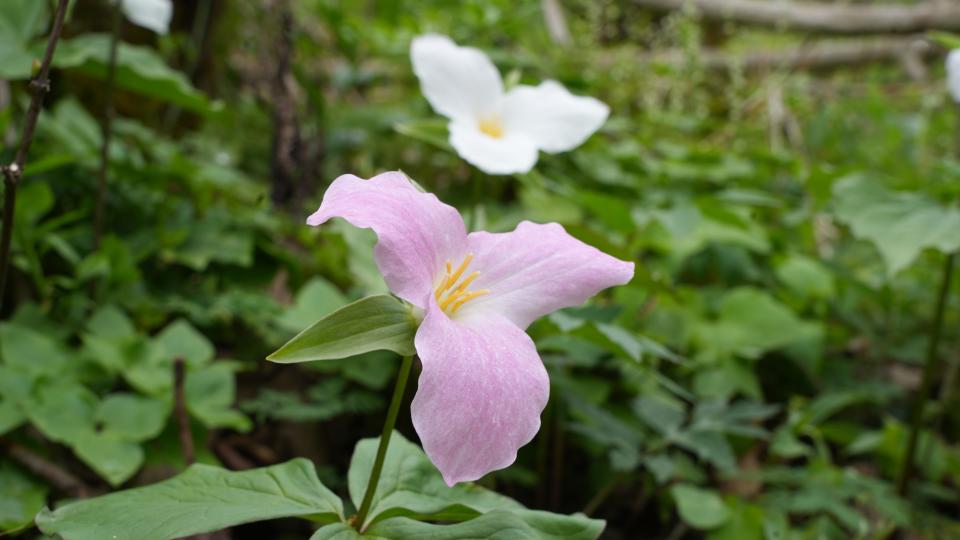Wildflowers are in bloom across Sandusky, Ottawa counties. What to look for now.
Just when we think we can’t take another day of winter weather, a variety of wildflowers are starting to grow.
Called ephemerals, these are short-lived and can be found in moist areas near creeks. Trees have yet to leaf out so these wildflowers bloom now, taking advantage of the sunlight. They also provide pollen for a variety of insects and some birds.
Wear boots and dress warmly when wildflower hiking since these plants grow in wet areas. Do not pick the wildflowers or dig them up as they take many years to establish and only bloom for a short period. Picking the flower will prevent the plant from blooming again for several years.

Wildflowers can be found at several area locations
We are fortunate to live in a rural area and can easily find wildflowers. The Sandusky County Parks District, which includes 17 locations throughout the county, and the Ottawa County Parks are good places to visit. Park rangers can provide insight about locations for the wildflowers, so check with their offices before heading out.
State parks also offer good views. Be sure to stay on the boardwalks and trails.
Starting in mid-February, skunk cabbage is the first wildflower to appear and is followed by many others through May.
Here is more information about some of these ephemeral plants in order of their appearance:
● Skunk cabbage, Symplocarpus foetidus, blooms mid-February through early April when snow and ice are still present. Leathery liver-spotted spathes are hooded over the spadix and tiny greenish-white flowers before the leaves appear. The flower structure is thermogenic, producing heat that melts the surrounding snow and ice. After flowering, the plant produces huge foul-smelling leaves which give the plant its common name. Skunk cabbage colonies can be viewed through summer, but the flower will long since have waned.
● Harbinger-of-spring, Eringenia bulbosa, blooms in mid- to late February through mid-April. This perennial is only an inch or 2 inches high. Its parsley-like leaves arise from the upper stem and the tiny white flowers have contrasting purple anthers. This contrasting color lends itself to another common name, pepper-and-salt. Principal pollinators are tiny native bees and flies.
● Cut-leaved toothwort, Cardamine concatenata, blooms from early March to late April. Its name comes from the three leaves that grow on the upper stem. They are deeply divided and prominently toothed. The white four-petaled flowers bloom from the bottom to the top of their raceme. An early-season source of nectar for native pollinators, it is also a food source for caterpillars.
Bloodroot blooms through late April
● Bloodroot, Saguinaria canadensis, blooms from mid-March to late April. The large showy flower has numerous white petals that often fall within one day of blooming. The single leaf wraps the stem at flowering and then expands into a large, rounded leaf with lobed margins and a deep basal sinus. Orange-red juices from the roots give this wildflower its common name and have been used as a dye, medicinal treatments for asthma, laryngitis and fevers. An alkaloid, sanguinarine, is used commercially in mouthwash and toothpaste to help combat plaque.
● Spring beauty, Claytonia virginica, blooms from mid-March to early May. This wildflower is also known as fairy spuds because of the tuber. Two or more stems grow from each tuber, producing two straplike leaves and whitish- or pink-tinged flowers. Pollinating insects like native bees and some flies visit the flowers for an early source of nectar.
● Dutchman’s-breeches, Dicentra Cucullaria, blooms from late March to early May. Distinctive white flowers dangle from pendant-like pedicels on elongated racemes. The leaves are highly dissected. This wildflower’s common name comes from the appearance of the flower, which looks like a pair of white breeches hung upside down. Chief pollinators are bumblebees.

● Large-flowered trillium, Trillium grandiflorum, flowers from April to early May. Topping the 20-inch-tall stem are three-petaled bright white flowers well above the whorl of three large leaves. This was named Ohio’s state wildflower in 1986. White-tailed deer like them.
● Squirrel-corn, Dicentra canadensis, blooms early April to early May. A cluster of distinctive white heart-shaped fragrant flowers dangle from erect or leaning stems. The bluish-green leaves are highly dissected. This wildflower gets its name from the small yellow tubers that resemble a corn kernel. Common pollinators are bumblebees.
● Virginia bluebells, Mertensia virginica, blooms from April to May. These perennials are 2½ feet tall with showy blue flowers and large ovate leaves. It is dependent on longtongued bees, especially bumblebees, for pollination. Also visiting these flowers are a variety of butterflies, moths and some hummingbirds.
● Wild geranium, Geranium maculatum, blooms April to July. Small clusters of rosepurple flowers appear on long stems. Leaves are highly dissected and toothed. Another common name is crane’s bill, derived from the appearance of the fruit before it releases the seeds.
There are many other wildflowers. You can get more information from your local parks district or the Ohio Department of Natural Resources.
Some wildflowers are endangered by the spread of invasive non-native plants. Many toothworts and other native wildflowers have been displaced by the invasive garlic mustard, Alliaria petiolate. The roots of the plant release chemicals that affect the native plants and inhibit tree growth.
You might even find this pesky plant in your yard or garden. Organized garlic mustard hunts rely on volunteers to pull up the plant before it goes to seed. Pulled plants should be bagged and placed in the garbage. Do not compost them.
Christine Michael is a Master Gardener with the Extension Offices in Sandusky and Ottawa Counties.
This article originally appeared on Fremont News-Messenger: Spring wildflowers bloom across Sandusky, Ottawa counties in Ohio

